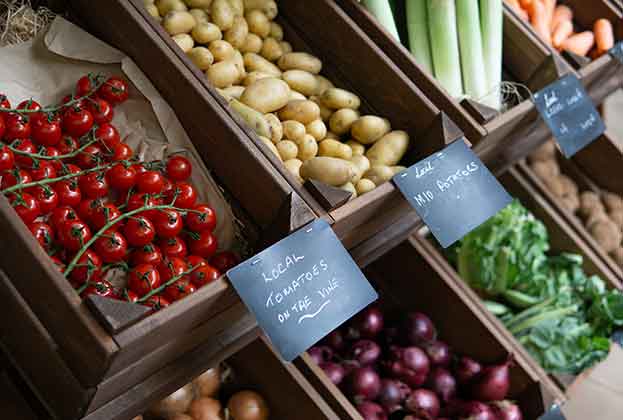As costs increase and subsidies decrease, the case for diversification grows. Creating relevant and in-demand offerings is key to overall success
TOP THREE TAKEAWAYS
- As BPS support fades, farm and estate diversification builds business resilience
- Future-proof existing rural tourism and leisure businesses by expanding the offer with new events, experiences or attractions
- Remain aware of macro themes that are driving consumer demand, such as sustainability, wellbeing and in-person experiences
Diversifying income streams
Welcome to our latest research publication on rural tourism and leisure. Farms and rural estates face constant pressure and uncertainty from diminishing subsidies, government policy, rising costs, climate change and the growing importance of sustainability, food and energy security. This publication focuses on rural tourism and leisure diversification and includes a special feature on how new ideas and innovation can bring opportunities, resilience and strength to a business.
According to Defra, 42% of farms are unprofitable without Basic Payment Scheme support (BPS). Agricultural subsidies were introduced to financially support farms in difficult years (such as 2015/16) and strengthen stronger years (2017/18) (figure 1). As BPS support fades, agri-environment scheme payments will take its place but will typically offer less support, and there are costs to participation, too. This shift in agricultural support will force loss-making farms to rethink their business focus, cut fixed costs and possibly explore opportunities for diversification.
Without subsidy, Defra suggests a business with an average income would have to reduce costs by 10% just to break even. Moreover, farms classified in the bottom 10% in terms of farm business income would have to reduce costs by 31% to achieve the same. Diversification represents an opportunity to develop an alternative income stream which looks to utilise business assets and spread income fluctuation risk.
Over the years, many farms and estates have supplemented their traditional farming income by diversifying their business. During 2022 around half (51%) of farmers earned some form of income from a diversified enterprise other than let buildings, according to DEFRA analysis. This compares to 33% ten years before.
The decision to diversify is triggered by many factors, but the most common reason is to provide an increased and more stable income from the farm or estate
Nicola Buckingham, Associate Director, Rural Research
The range and types of diversifications have increased too. Some are very much related to the core farming enterprise, such as providing contracting services to other farmers, letting land for specialist crops, producing an alternative crop or shortening supply chains and adding value by using on-farm processing facilities. Others are people-focused and include agri-tourism, farm shops, rentals, training and on-farm experiences. In recent years, the internet and changing customer expectations have influenced and encouraged new and interesting opportunities for farm-based activities.
The decision to diversify is triggered by many factors, but as highlighted above, the most common reason is to provide an increased and more stable income from the farm or estate. Products or services produced by many businesses have a fixed price, or one set by the business, however, most conventional farming businesses are market price takers rather than makers. Prices can fluctuate (widely in some years) and can present significant risks in terms of uncertainty of income and the lack of ability to forecast. Farm diversification enables farmers to be in more control of setting prices.

WHAT IS IN DEMAND?
Figure 1 demonstrates average income from farm diversification is steadily rising and regularly outperforms environmental incomes. This is only an average figure and to be among the top-performing rural diversifications, operators must remain aware of their market and customer preferences and attitudes. The dominant macro themes of sustainable living, wellbeing and experience over possessions continue to impact consumer decisions.
Our research explored the number of searches for a selection of keywords associated with rural business activities through Google search trend data (figure 2). Interestingly, with the exception of bed and breakfast, the number of searches for these activities has increased since 2019, indicating how experiences have the ability to recover from significant events such as Covid-19. The level of interest varies depending on the activity, for example, searches for ‘music festivals’ were slower to recover, but are benefiting from booming interest in 2023. ‘Wine tasting’ has seen a more linear and gradual increase over recent years. The more traditional accommodation diversification such as ‘bed and breakfast’ has not seen interest recover to pre-Covid levels. Finally, the keyword search ‘farm shop’ saw a surge in interest related to Covid-19 but is now seeing steadier levels of growth.
Attracting custom through the exploration of new markets can increase brand exposure, attract new business and establish new, revenue streams. The overall enterprise benefits from cross-selling across different sections of the business. For example, offering cooking classes or distillery tours can promote sales of produce. A single, isolated event is transformed into a broader experience for the customer, which in turn promotes repeat custom and added value for the enterprise.
THE RURAL VIBRANCY INDEX
The Savills Rural Vibrancy Index (RVI) tracks some of the key influences on farm tourism and leisure enterprises and aims to give a comparative indication of the strength of the rural tourism and leisure sector over time. The RVI combines a wide range of indicators in three headline categories: farm performance, the wider economic environment and the performance of leisure and events businesses.
The nation’s economy has endured tough conditions after the pandemic and continues to wrestle with inflation. Farm businesses have faced increased costs as a result; however, income figures suggest improved prices combined with robust yields have more than compensated for these changes in 2022. Since then, high inflation has persisted longer than thought but is expected to ease. Many costs remain elevated and commodity markets have fallen so margins have worsened.
The leisure and events index performs well overall but has mixed fortunes on closer inspection. Visitor attractions continue to benefit from a recovery in visitor numbers post-Covid as consumer desire for experiences persists. Weddings have seen the flow of pent-up demand begin to wane and costs are a concern, but certain venues such as barns are enjoying heightened demand (Top themes graphic, below). Looking ahead, the cost of living crisis is likely to have a negative impact on tourism and leisure enterprises.
Overall rural vibrancy improved in 2022, underpinned by strong on-farm performance with diversified businesses playing no small part in that success. 2023 will prove to have been a difficult year for rural businesses and looking ahead a continued focus on new ideas and raising business profile, visitor footfall, visitor spend and profit margins will be key to ensure continued success.
Figure 3 shows how the indices performed in 2022, relative to 2021.
TOP THEMES FOR THE RURAL TOURISM, LEISURE AND EVENTS SECTOR
Consumers purchasing habits support the macro themes of sustainability, wellbeing and experiences, but they also presently have one eye on cost. How can rural entrepreneurs incorporate these macro themes into their tourism and leisure businesses? We analyse key enterprise types to determine how macro themes are impacting the sector.
Read the articles within Spotlight: Rural Tourism and Leisure below.


